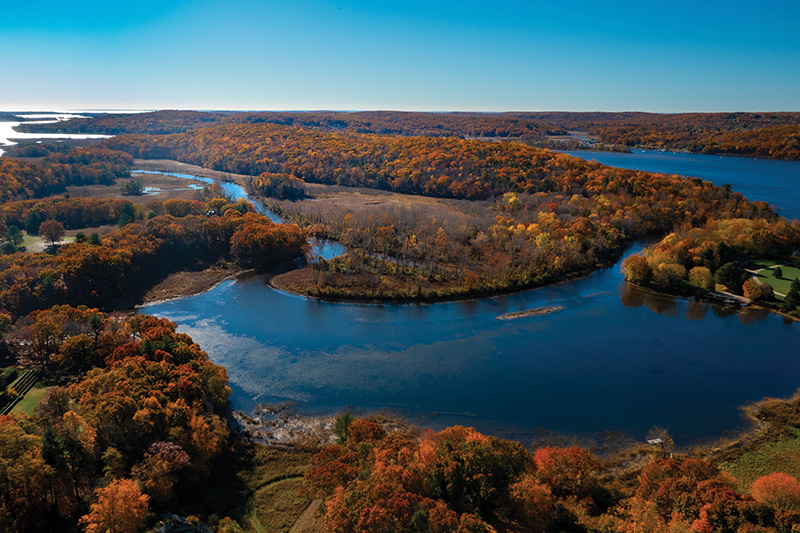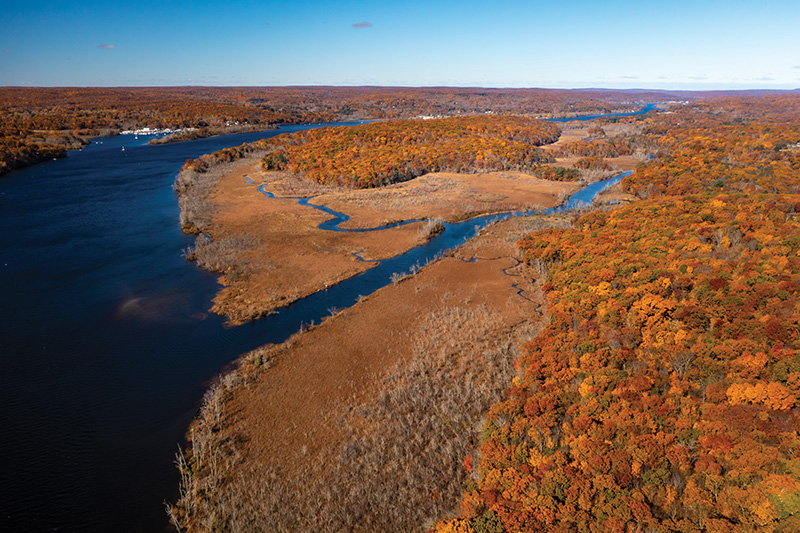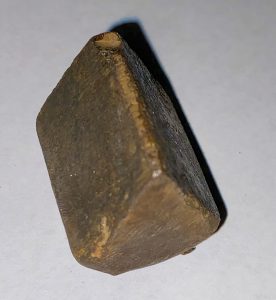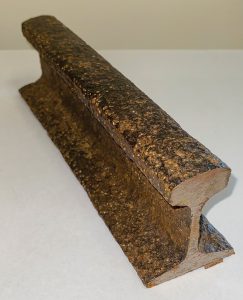
Part of the Connecticut River, at right, diverts around Selden Island forming Selden Cove, in
the foreground, and Selden Creek, at left.
Image Credit: Christopher Zajac
An Island Treasure
Not to be Passed By
 Selden’s shoreline bristles with looming hardwoods and a thorny understory. Surrounded by a natural moat, this verdant fortress, the largest island along the Connecticut River, is easily mistaken for the mainland.
Selden’s shoreline bristles with looming hardwoods and a thorny understory. Surrounded by a natural moat, this verdant fortress, the largest island along the Connecticut River, is easily mistaken for the mainland.
Why would you stop? Virtually all of its 600-odd acres are what American colonials would have dismissed as a howling wilderness, an untamed place beyond the pale of civilization. It might as well be 1492 over there.
But Selden was not always thus. It was tamed for a time. More than a century ago, as the twentieth century dawned, trees were as scarce as landing spots are today, and the island buzzed with humanity and industry. At different times it has been awash in fishermen and farmers, Native American and white settlers, loggers and miners—not to mention the odd hermit or rumrunner on the lam.
Selden stories, too, are as thick as the canopy is today; some of them might even be partly true. Indeed, the island’s myriad mysteries would tax Sherlock Holmes, who was portrayed on Broadway by William Gillette—the thespian who built a faux castle about a mile north of the island.

Selden Creek meets the Connecticut River, at left, at the southeastern tip of Selden Island. Selden Island, now a Connecticut State Park only accessible by boat, was once famous for its granite quarry providing architectural stone to projects in New York City. Image Credit: Christopher Zajac
Here’s a verifiable Selden story: Billy Joel paddled by the island and rocked out in a soulful music video for his album River of Dreams. It features local kids jumping off of steep rock outcroppings into Selden Creek—which is dangerous and totally illegal, so all the more a compelling right of local passage.
David Wordell passed Selden by for decades on his Connecticut River jaunts from Essex to Gillette Castle or up past Hartford to Windsor Locks, skippering his cape cod sailboat that sported a five-horse engine. Wordell never disembarked, not once. In the 1950s he and his teenage buddies got pretty close, though, often plying Selden Creek, which separates the island from the Connecticut mainland and Lyme proper. “The trees used to overhang the creek making an archway,” he remembers. “It was like you were going down the Amazon.”
Time and erosion have since widened the creek, and the archway is gone, but the sensation of pristine solitude remains. On a summer weekday morning a kayaker is likely to encounter only osprey, American egrets, belted kingfishers, and such along the two-mile-long channel. Big boats ply the creek at their peril.
Still, for a quarter of a century, right up until 1975, David Wordell passed Selden by. That year he was asked a simple question that would change his future—and that of the Island. He was puttering up the creek with his 10-year-old son, David Jr., who suddenly realized, as they returned to the Connecticut River’s main channel, that the wooded expanse they had passed by was an island. That, of course, made it way cooler than the mainland. David asked, “Dad, have you ever been on that island?”
Soon enough father and son ventured onto Selden and began exploring (it wasn’t as overgrown back then) and they encountered the darndest things: old steel derricks and thick metal cables, elegantly cut paving stones strewn about, farmhouse foundations, and quarry pits—the detritus of centuries of civilizations. Later, archaeologists would unearth evidence of Native American habitation going back thousands of years.
Selden had not always been a lonely place; anything but. It was conveyed to a colonist in 1652, just fifteen years after the Pequot War and twenty-three years before King Philip’s War, the last great conflagrations between southern New England colonists and the Indigenous people who have lived here for millennia.
In 1696 the island was sold to Joseph Selden, who cleared and farmed the land and also controlled the local fishing rights for shad, salmon, eels, sturgeon, and menhaden. The island wasn’t an island back then, but rather a neck, or peninsula, connected to the mainland by a narrow spit of land. A flood in 1854 demolished the link, creating Selden as it is today.
The island was sold to the Lord family and eventually to the state of Connecticut, in pieces, for a park beginning in 1917. The state calls it Selden Neck State Park and has established four rustic campsites there that people can reserve online and access only by boat.
But the Seldens remained, at their family homestead on the mainland, just across Selden Cove. They stayed for more than 280 years, nine generations. They sold most of their land in 1976 and the remaining parcel in the 1980s. The last patriarch, Albert Selden (1922–1987), was a noted Broadway producer who took the megahit Man of La Mancha from the Goodspeed Opera House, which overlooks the Connecticut River in East Haddam, to New York City’s Great White Way.

Bull Wedge: After a row of shallow vee cuts had been made with large chisels using heavy sledgehammers, these small wedges were placed in each depression. With rhythm of uniform blows down the line, the rock could be split.

Derrick Cable: This is a rusted section cut from a stabilizing cable. Today, cable a fraction of this diameter will support the same weight due to improved metals and methods of manufacture.

Steam Drill Bit: This bit was threaded to the end of the drill shaft so that it could be easily removed and sharpened by the blacksmith located on the site. At the time of Selden's quarrying operation, no carbide tips existed and tools had to be frequently sharpened by the blacksmith's hammer. the bit allowed compressed air out at the bottom of the hole blowing out the pulverized stone.

Hand Edge Chisels: These three tools of varying widths were used in the finishing stages of roughing out the final shape of the paving block. These tools were forged by the Bicknel Manufacturing Company of Rockland, Maine.

A section of rail found on Selden Neck in 1986. The rail is from a narrowgauge railroad used on Selden Neck to haul the cut stone from the quarries to the wharf. It was then loaded onto schooners and taken to New York.

Hand Point: This tool was used to remove large irregularities in squaring off the rough shape of the paving block.
Images Courtesy of David Holahan
Selden Island got much busier in 1889, when a New York City firm established the Connecticut Valley Granite and Mining Company there. The island’s rock outcroppings made ideal raw material for manufacturing paving stones that were in demand for city streets in places like Coney Island. Schooners, some likely built in nearby Essex, transported the pavers.
The mining outfit introduced the industrial revolution to Selden virtually overnight. It imported steam drills, cranes, and derricks; established a narrow-gauge railroad to move the stones; built five wharfs along the western shoreline, one for each quarry gouged out of the island; and erected two blacksmith forges and a 300-foot-long boarding house for some 600 men, many of them skilled stonecutters who hailed from Italy. The Deep River New Era, a local newspaper, reported in 1891 that the men were producing an astonishing 3,500 paving stones a day. They would keep cutting the island into little pieces until 1903, when the company went bankrupt and skedaddled, leaving an industrial mess in its wake.
The scarred island slowly healed, happily evolving back into a howling wilderness. The resurgent lushness obscured its history—that is until David Wordell and David Jr. rediscovered Selden. Wordell the elder began visiting libraries and town halls to tease out facts and tales from centuries gone by. He interviewed people who had been alive when the mining operation was humming. Lyme officialdom had compiled an inventory of the equipment there in order to tax the firm, which objected to paying in a letter sent to the town.
The research took seven years, and Wordell and son produced a wonderful video about the glories of the forgotten island. Starting in the 1980s the elder Wordell, a schoolteacher at the time, began making presentations to historical societies, libraries, schools, and other interested organizations throughout Connecticut.
He would captivate his audiences with tales about the mysterious Egyptian lilies that somehow had managed to find their way from the Middle East to bloom in Selden’s marshes; about the jilted hermit who parked his boat in Selden Cove and for 50 years never spoke to a soul; about the purported murder of the Italian cook who had bragged too loudly about all the money he’d socked away working for the mining company.
Wordell was written up in the local media, and before long the curious began making their way out to the island to see it for themselves. One gentleman got dangerously lost, thrashing about all night looking for his boat. An official from the Connecticut Department of Energy and Environmental Protection (DEEP) called Wordell and told him that he was creating problems for the state. Maybe what he needed to do was to blaze some pathways so people wouldn’t get lost in the howling wilderness.
So in the early 1980s, Wordell, his wife, Lois, and their son, David, went to work, clearing a network of trails—the red, the blue, and the green—in the middle of the island. They carved three miles of looping footpaths. You can follow the blue trail to the island’s peak, 226 feet above sea level, for a sweeping view of the river and the town of Deep River to the west. Today this promontory is known as Wordell Point.
A decade later, in the mid-1990s, keeping the trails open became even more arduous because hemlock trees, afflicted by an invasive pest, began dying and falling across the pathways. Paul Robertson, a generation younger than Wordell, took up the challenge. He also added the white trail, which runs from the northern tip of the island south for about a mile, connecting with Wordell’s curvaceous network.
Robertson passed away in 2010, but videos of him leading tours of Selden can be found online. The trails suffered for a time, but others have stepped up to the plate swinging axes and weed wackers.
The Tree Collective of the Lyme Land Trust joined the battle in recent years. The band of local teenagers has camped out on the island and re-blazed most of the white trail. “The island is gorgeous, and there is the most incredible energy there,” says their adult supervisor Regan Stacey. “Over time we hope to get all the trails back in shape.”
On the waterside, volunteers from Friends of Whalebone Cove have helped to clear Selden Cove and Selden Creek (among other local places) of invasive plants, such as water chestnut and waterthyme, which can cover the surface like a suffocating green blanket. State employees also have volunteered their time to make Selden more accessible, according to John Hine, DEEP supervisor for the island and the region.
Many underfunded Connecticut parks, such as nearby Gillette Castle State Park, have “friends” groups whose members do things that the state budget doesn’t cover. Hines is hoping a group will coalesce and adopt Selden Neck State Park.
Following in Wordell’s footsteps, Steve Gencarella of Lyme, an academic and a folklorist, has examined the mysteries of Selden Island and found many of them wanting. They have since been washed away, he says, but the Egyptian lilies were actually a southern American species that likely made its way north thanks to Native American trade networks. He devotes a chapter to Selden in his 2019 book, Spooky Trails and Tall Tales Connecticut: Hiking the State’s Legends, Hauntings, and History.
One thing is indisputable, according to Gencarella: “I am so grateful that people preserved the island and have taken care of it for more than a century; we are the beneficiaries of remarkable wisdom.”

